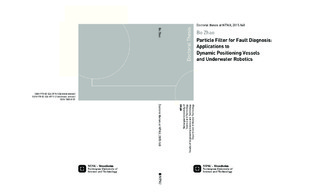Particle Filter for Fault Diagnosis: Applications to Dynamic Positioning Vessels and Underwater Robotics
Doctoral thesis

Åpne
Permanent lenke
http://hdl.handle.net/11250/296033Utgivelsesdato
2015Metadata
Vis full innførselSamlinger
- Institutt for marin teknikk [3432]
Sammendrag
Safety remains an important consideration in control system design. This is particularly
true for the control systems that are employed by the offshore petroleum and
maritime industries, in which authorities continually claim to have developed more
and more rigorous methods and processes to ensure safety and reliability. In addition
to the use of more traditional approaches to conducting redundancy design, backup
system design, robust design, and failure mode and effect analysis, these methods often
involve the use of fault tolerant design to enhance the safety and reliability of the
control system.
As a common practice, segregation and redundant design are used for dynamic positioning
vessels to isolate faulty components and prevent the propagation of faults.
However, many incidents still occur as a result of fault escapes from the segregation
on a torpid detection. In more severe cases, false detection can actually cause faults
and may result in an even more dangerous situation that has more catastrophic consequences.
Hence, precise and timely fault diagnosis is necessary for the operator or the
automation system to take appropriate action.
This thesis presents a brief overview of the existing fault diagnose methods, with a
particular focus on particle-filter-based framework for fault diagnosis. The paper commences
with a brief review of the background, theory, and typical features of the particle
filter before progressing to examine the relationships and differences between the
particle filter and other traditional stochastic filters. Switching mode hidden Markov
model were employed to model a system with potential faults and a new methodology
that uses a particle filter as fault diagnosis filter was developed. This method was
then applied on an underwater robotic, which worked in complex environmental disturbance
and suffered from different failure modes. Experimental results from ROV
sea trails verified that the new fault diagnosis design is effective and reliable.